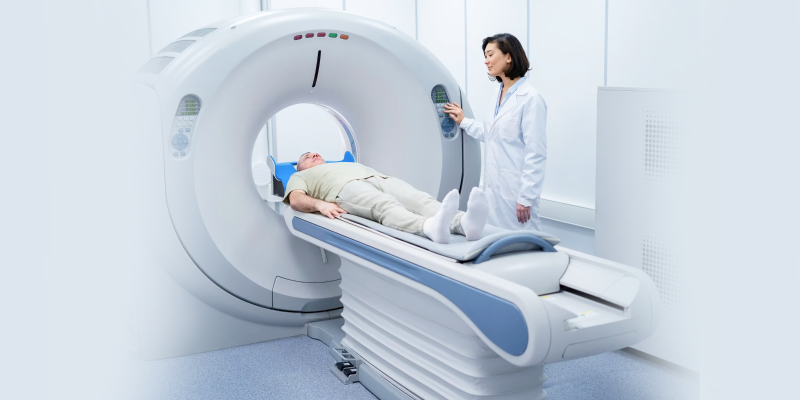

Teleradiology
Improvement of Patient Care Through Teleradiology
Teleradiology Solutions
It is estimated that the global teleradiology market size will reach USD 8.2 billion by 2024, with a CAGR of 19.1%. Teleradiology is uniquely positioned to deliver radiological interpretation in emergencies and provide access to 2nd opinions from experts in the field. While it allows flexible temporal and specialty-based opportunities that augment image interpretation capacity the real emphasis is on value-directed care. Teleradiology has not only improved access but also improved optimal imaging care both temporally and geographically. A decade ago, the focus was on image quality, transmission speed, and image compression. Now the focus is on clinical governance, medico-legal issues, and quality assessment.
Teleradiology solutions were initially expected to allow radiologists to provide intramural emergency radiology services from home, focusing on underserved areas and augmenting subspecialty coverage. However, the number of emergency department imaging cases exploded between 1994 and 2015, leading to a significant strain on radiology departments worldwide.
Value-directed care
The era of value-directed care is emphasizing patient primary and optimizing patient care. Many studies have shown the poorer quality of health care for patients admitted on weekends or overnight when compared to those admitted during the week. Data from Sentinel Stroke National Audit Programme showed that care quality showed different patterns and magnitudes of temporal variation. The role of diagnostic imaging in this care gap has not been studied yet. Orthopaedic trauma units have benefitted, where an orthopaedist is at a remote location from the patient, teleradiology has been shown to improve diagnostic accuracy, planning the disposition of patients from emergency departments, and planning surgical procedures. This also improves the comfort level of consulting surgeons and limits the risk of litigation for an incorrect diagnosis.
Teleradiology decreases the report turnaround time and improves service levels in the emergency setting. There are generalists who excel in acute care interpretation. Report quality is enhanced by a centralized reading room that is equipped with the night-day model. This increases radiologist productivity and healthcare costs are reduced.
Expanding Access
There is a great disparity between rural and urban settings for healthcare. In a country like the US, one-fifth of its residents live in rural areas. There are more general radiologists in non-academic practices and smaller practices in certain regions of the United States. Some interpretations may benefit from subspecialist interpretations. Hence teleradiology can eliminate any interpretative gap that may exist. Older individuals with lower socioeconomic status with more health issues in rural can be served by contemporaneous around-the-clock imaging services in rural areas and providing subspeciality diagnostic interpretations at their local hospitals.
Disaster management
Teleradiology has played a critical role in war-affected regions of Iran, Syria, and Afghanistan. Doctors without Borders, a widely recognized NGO uses teleradiology to assist with healthcare outreach. More than half of all radiographs sent to them were nondiagnostic because of poor exposure and artifacts during film development. Radiographer training and transition to computed radiography helped where possible. During the COVID-19 pandemic, intramural teleradiology allowed radiologists to work from home to avoid exposure and provide interpretations from home. Emergency department imaging volume surge was handled efficiently by virtue of teleradiology during the pandemic.
Artificial Intelligence in Teleradiology
Artificial intelligence (AI) in teleradiology offers the potential for speed, accuracy, and quality of image interpretation. More urgent cases can be triaged and assigned to radiologists with the best-matched availability to render a high-quality interpretation. AI holds the promise of assisting with scheduling and developing a protocol, optimizing workflow, targeting image interpretations, improving intelligent communication, and optimizing business analytics and operations.
Technology limitations
Interpretations in teleradiology should be led by relevant clinical information. Access to this information may be a challenge. Studies have shown that state-wise teleradiology networks resulted in fewer repeat CT examinations, decreased cumulative radiation exposure, decrease time in emergency departments and cost savings. Hence a need for long-term support and standard PACS and electronic medical record system that can provide information without compromising health information security. Radiologists should have the responsibility to oversee technologists and sonographers acquiring images. There should be ease of access to the clinical provider who ordered the image with the teleradiologist too. A reliable internet connection with sufficient bandwidth can ensure the efficient transfer of radiographic images and remote report generation and transmission. Both the receiving and transmitting sites should have reliable and consistent peer-review feedback that is audible, private, and secure.
Conclusion
Teleradiology not only increases imaging efficiency but also bridges geographical and temporal discrepancies in imaging care. There may be however regulatory hurdles and technological limitations that may limit the optimal practice of teleradiology solutions Bangalore.
More from AMI
Revolutionizing Indian Healthcare: Unlocking the Potential of Teleradiology in Remote Areas
27/09/2023
Career in Radiology
29/08/2023
Imaging Instrumentation Trends In Clinical Oncology
26/06/2023
Emerging Techniques in Radiology By Dr. Namita
10/11/2022
Safe Radiology Practise for a safer world, safer health
30/11/2022
Test
27/03/2024
Sports-Related Injuries and the Importance of Radiology
30/01/2023
Imaging In Pregnancy
18/01/2023
How to Choose a Prospective Teleradiology Service Provider
04/08/2023
Empowering Radiologists-Teleradiology Redefines the Role of Imaging Specialist
09/10/2023
How to increase the efficiency of the Radiology Equipment
18/08/2023
Intra- Operative 3D Imaging With O- Arm Making Complex Spine Surgeries Safe and Accurate
30/11/-0001
10 Strategies To Prevent Burnout In Radiology
09/01/2023
Advances In Neuroradiology
06/01/2023
What is Diagnostic Radiology? Tests and Procedures
11/08/2023
Behind The Scenes of Teleradiology: How Digital Imaging Is Changing Diagnostic Medicine
16/10/2023
Teleradiology's Contribution to Timely Emergency Diagnoses
04/10/2023

AMI Expertise - When You Need It, Where You Need It.
Partner With Us
